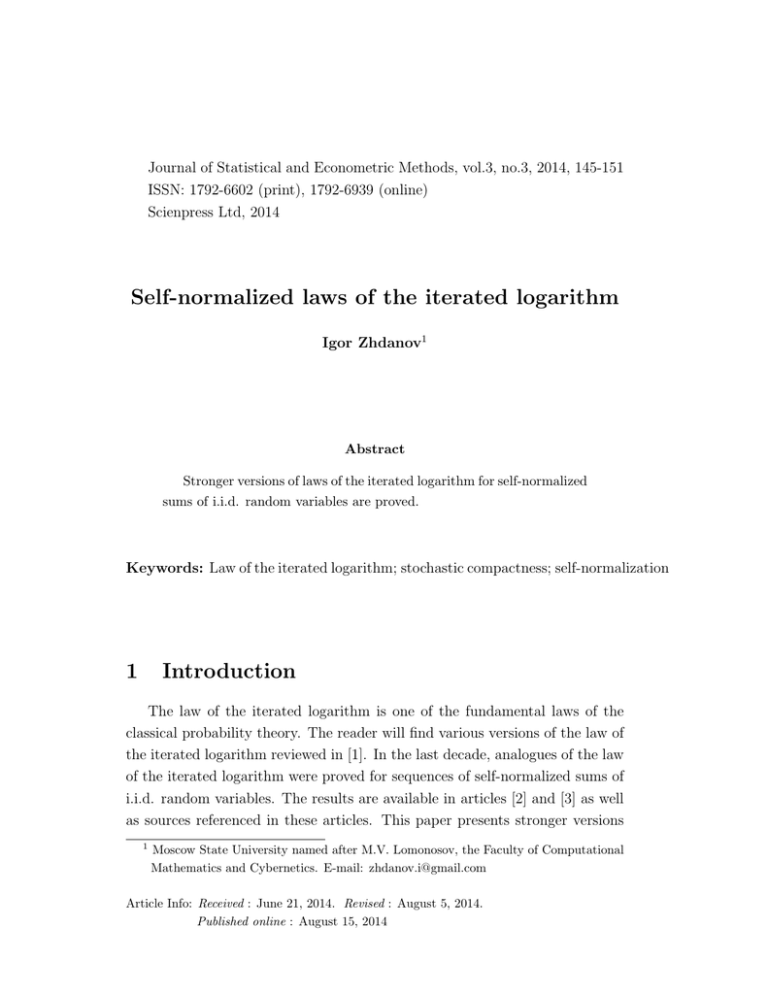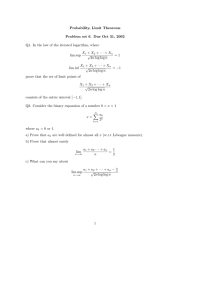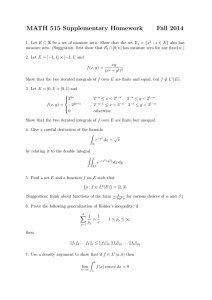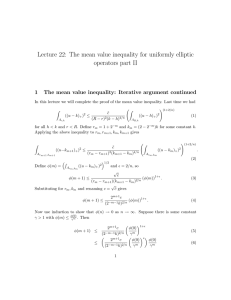Journal of Statistical and Econometric Methods, vol.3, no.3, 2014, 145-151
advertisement

Journal of Statistical and Econometric Methods, vol.3, no.3, 2014, 145-151
ISSN: 1792-6602 (print), 1792-6939 (online)
Scienpress Ltd, 2014
Self-normalized laws of the iterated logarithm
Igor Zhdanov1
Abstract
Stronger versions of laws of the iterated logarithm for self-normalized
sums of i.i.d. random variables are proved.
Keywords: Law of the iterated logarithm; stochastic compactness; self-normalization
1
Introduction
The law of the iterated logarithm is one of the fundamental laws of the
classical probability theory. The reader will find various versions of the law of
the iterated logarithm reviewed in [1]. In the last decade, analogues of the law
of the iterated logarithm were proved for sequences of self-normalized sums of
i.i.d. random variables. The results are available in articles [2] and [3] as well
as sources referenced in these articles. This paper presents stronger versions
1
Moscow State University named after M.V. Lomonosov, the Faculty of Computational
Mathematics and Cybernetics. E-mail: zhdanov.i@gmail.com
Article Info: Received : June 21, 2014. Revised : August 5, 2014.
Published online : August 15, 2014
146
Self-normalized laws of the iterated logarithm
of some of the known statements regarding the law of the iterated logarithm
for sequences of self-normalized sums of i.i.d. random variables.
Let i.i.d random variables Xn , n ∈ N = {1, 2, . . . }, be defined on a probability space (Ω, F, P). Denote Sn = X1 +· · ·+Xn , Vn2 = X12 +· · ·+Xn2 , n ∈ N. A
self-normalized sum Sn /Vn is correctly defined on the set {Vn > 0}. For Sn /Vn
to be defined on the entire set Ω, we put Sn /Vn = 0 on the set {Vn = 0}.
Define a function λ(n), n ∈ N, by putting λ(n) = 1 for n = 1, . . . , 9 and
λ(n) = [n − n/ ln ln n] for n ∈ N, n ≥ 10. Square brackets stand for an integer
part function of the number in the brackets. The nonnegative integer function
λ(n), n ∈ N, has the following properties: λ(n) ≤ λ(n + 1) for all n ∈ N and
λ(n) < n for n ∈ N, n ≥ 10,
λ(n)
= 1, lim (n − λ(n)) = ∞.
n→∞ n
n→∞
lim
(1)
Theorem 1.1. (i) If a sequence {Sn /Vn }n≥1 is weakly compact, then
|Sk |
< ∞ a.e.
λ(n)≤k≤n Vk
lim sup(2 log log n)−1/2 max
n→∞
(2)
(ii) If random variables Xn , n ∈ N, are symmetric, then
|Sk |
≤ 1 a.e.
λ(n)≤k≤n Vk
lim sup(2 log log n)−1/2 max
n→∞
(3)
As an immediate consequence, we get statements from the article [2].
Corollary 1.2. (i) If a sequence {Sn /Vn }n≥1 is weakly compact, then
lim sup
n→∞
Vn
√
|Sn |
< ∞ a.e.
2 log log n
(ii) If random variables Xn , n ∈ N, are symmetric, then
lim sup
n→∞
2
Vn
√
|Sn |
≤ 1 a.e.
2 log log n
Supporting lemmas
Virtually all of the following lemmas are known to specialists. Let Fn =
σ(Sk , Vk2 , k ≥ n) denote a σ-algebra generated by random variables Sk , Vk , k ≥
n.
147
Igor Zhdanov
Lemma 2.1. If E|X1 | < ∞, then for any n ∈ N and k = 1, . . . , n + 1 we
have
k
E(Sk |Fn+1 ) =
Sn+1 a.e.
(4)
n+1
Proof. Equalities similar to (4) are offered as an exercise in some advanced
textbooks on probability theory. It is also used in [2]. We were unable to find
a source that has a proof of this equality. At the same time, the proof of
our theorem is based on equality (4). For this reason we will give its proof
here. It suffices to show the equality of conditional mathematical expectations
E(Xk |Fn+1 ) = E(X1 |Fn+1 ) a.e. for any k = 1, . . . , n + 1. Then (4) follows from
additivity of conditional mathematical expectation. Let L denote a class of
events A ∈ Fn+1 , for which the following holds
Z
Z
Xk dP =
X1 dP.
(5)
A
A
Since X1 Xk are i.i.d, equality (5) holds with A = Ω. If equality (5) holds
for B, C ∈ Fn+1 and B ⊂ C, then it holds for A = C \ B due to integral’s
property of linearity. If equality (5) holds for events An , n ∈ N, and An ⊆ An+1
for all n ∈ N, then it holds for A = ∪∞
n=1 An by the dominated convergence
theorem. This implies that class L is a λ-class. Let C denote a class of events
such as A = {Sk1 < c1 , , . . . , Skr < cr , Vm2 1 < b1 , . . . , Vm2 l < bl } for natural
numbers r, l, n + 1 ≤ k1 < · · · < kr , n + 1 ≤ m1 < · · · < ml and for real
numbers c1 , . . . , cr , b1 , . . . , bl . It is easy to verify, using the integration measure
change theorem, that equality (5) holds for any A ∈ C. Intersection of any two
events from class C is in C. In other words, class C is a π-class. Clearly, π-class
C generates σ-algebra Fn+1 . By Sierpinski’s theorem ([4], p. 5), sigma-algebra
σ(C) generated by class C is in λ-class L. Since Fn+1 = σ(C) ⊆ L ⊆ Fn+1 ,
it follows that L = Fn+1 . Thus we proved that equality (5) holds for any
A ∈ Fn+1 , which is equivalent to equality E(Xk |Fn+1 ) = E(X1 |Fn+1 ) a.e. This
completes the proof of Lemma 1.
The following lemma demonstrates an important property of random variables
³
n
Sn+m−k ´2
Yk =
, n, m ∈ N, k = 1, . . . , m.
n + m − k Vn+m−k
Lemma 2.2. Random variables Yk , k = 1, . . . , m, form a submartingale
relative to filtration Fn+m−k , k = 1, . . . , m.
148
Self-normalized laws of the iterated logarithm
Proof. In essence, a proof of this lemma is provided in [2]. We include it
here for the reader’s convenience. It is easily seen that for any k = 1, . . . , m
the random variable Yk is measurable with respect to sigma-algebra Fn+m−k ,
and EYk < ∞. To complete the proof of the lemma, we have to verify that the
submartingale condition Yk ≤ E(Yk+1 |Fn+m−k ) holds a.e. for any 1 ≤ k < m.
We will make an additional assumption EX12 < ∞. By equality (4), an obvious
inequality Vn+m−k−1 ≤ Vn+m−k as well as Jensen’s inequality for conditional
mathematical expectations
2
(E(Sn+m−k−1 |Fn+m−k ))2 ≤ E(Sn+m−k−1
|Fn+m−k ) a.e.,
we have
³³
´
n
Sn+m−k−1 ´2
E(Yk+1 |Fn+m−k ) = E
|Fn+m−k
n + m − k − 1 Vn+m−k−1
³
1 ´2
n
2
E(Sn+m−k−1
|Fn+m−k )
≥
n + m − k − 1 Vn+m−k
³
n
1 ´2
≥
(E(Sn+m−k−1 |Fn+m−k ))2
n + m − k − 1 Vn+m−k
³
´2
n
1 ´2 ³ n + m − k − 1
=
Sn+m−k
n + m − k − 1 Vn+m−k
n+m−k
³
´
2
n
Sn+m−k
=
= Yk a.e.
n + m − k Vn+m−k
We will now no longer assume that EX12 < ∞. By 1A denote the indicator
(r)
function of an event A ∈ F and Xk = Xk 1{|Xk |≤r} for k = 1, . . . , n and r ∈ N.
(r)
(r)
(r)
(r)
Define random variables Sk = X1 + · · · + Xk and Yk similarly to Sk and
Yk . It is not difficult to see that
(r)
lim Yk
r→∞
(r)
= Yk a.e., lim E|Yk
r→∞
− Yk | = 0.
(r)
(6)
(r)
Applying the arguments shown above, we have Yk ≤ E(Yk+1 |Fn+m−k ) a.e.
Letting r → ∞, we obtain inequality Yk ≤ E(Yk+1 |Fn+m−k ) a.e. It is well
known that conditions (6) are sufficient to justify the limit operation on conditional mathematical expectations. This completes the proof of Lemma 2.
3
Main Results
(i). Denote nr = [exp{r/(log r)2 ] for any r ∈ N, r ≥ 2 and n1 = 1.
149
Igor Zhdanov
By Lemma 2 for n = λ(nr ) and m = nr+1 − λ(nr ), nr > 10, random variables Yk , k = 1, . . . , m, form a submartingale relative to filtration Fn+m−k , k =
1, . . . , m. For any t > 0 a convex function exp{tx), x ≥ 0, is increasing. Therefore, a sequence exp{tYk }, k = 1, . . . , m, forms a submartingale relative to
filtration Fn+m−k , k = 1, . . . , m. Denote
n
Ar =
max
λ(nr )≤k<nr+1
o
λ(nr ) |Sk |
> x(2 log r)1/2 , r ∈ N, nr > 10, x > 0.
λ(nr ) + k Vk
Event Ar can be written as
n
Ar =
o
n
|Sn+m−k |
> x(2 log r)1/2 = { max exp{tYk } > exp{2x2 t log r}}
1≤k≤m n + m − k Vn+m−k
1≤k≤m
max
By the maximum inequality for submartingales ([4], p. 93) we have
2
2
P{Ar } ≤ exp{−2x2 t log r}EetYm = exp{−2x2 t log r}E exp{tSλ(n
/Vλ(n
}.
r)
r)
(7)
2
2
In [5] inequality supn≥1 E exp{cSn /Vn } ≤ 2 is proven for some constant c > 0.
p
Putting t = c and x = 2/c in (7), we obtain P{Ar } ≤ 2/r2 , nr > 10, and
∞
X
X
P{Ar } ≤
r=1
X
+
r:nr ≤10
r:nr
2
< ∞.
r2
>10
By the Borel-Cantelli lemma, we have
lim sup(2 log r)−1/2
r→∞
max
λ(nr )≤k<nr+1
p
λ(nr ) |Sk |
≤ x = 2 2/c a.e.
λ(nr ) + k Vk
It is not difficult to verify that limr→∞ nr+1 /nr = 1 and limr→∞ log log nr / log r =
1. This along with the first statement in (1) implies that limr→∞ λ(nr )/nr+1 =
1. From this, in turn, it follows that
lim sup(2 log log nr )−1/2
r→∞
max
λ(nr )≤k<nr+1
p
|Sk |
≤ 2 2/c a.e.
Vk
(8)
For any n ∈ N there exists r ∈ N such that nr ≤ n < nr+1 and, consequently,
the following inequality holds
|Sk |
|Sk |
≤
max
.
λ(nr )≤k<nr+1 Vk
λ(n)≤k≤n Vk
max
This together with (8) proves (2).
150
Self-normalized laws of the iterated logarithm
(ii). If random variables Xn , n ∈ N, are symmetric, then E exp{tSn2 /Vn2 } ≤
2/(1 − 2t) for any t < 1/2. This statement is proven in the article [2]. Now
inequality (7) can be restated as follows
P{Ar } ≤ exp{−2x2 t log r}EetYm = exp{−2x2 t log r}
2
1
, t < , nr > 10.
1 − 2t
2
Put x = 1 + ε, where ε is any positive number. There exists t, 0 < t < 1/2,
such that 2(1 + ε)2 t > 1. For such x and t the previous inequality implies that
∞
X
P{Ar } ≤
r=1
X
PAr } +
r:nr ≤10
X
1
2
< ∞.
2x
1 − 2t r:n >10 r 2 t
r
By the Borel-Cantelli lemma we have
lim sup(2 log r)−1/2
r→∞
max
λ(nr )≤k<nr+1
λ(nr ) |Sk |
≤ 1 + ε a.e.
λ(nr ) + k Vk
Properties of numbers nr , r ∈ N, as well as the function λ(n), n ∈ N, referred
to in the proof of the first statement, imply that
lim sup(2 log log nr )−1/2
r→∞
max
λ(nr )≤k<nr+1
|Sk |
≤ 1 + ε a.s.
Vk
Using concluding arguments from the proof of the first statement, we can again
verify that
|Sk |
lim sup(2 log log n)−1/2 max
≤ 1 + ε a.e.
(9)
λ(n)≤k<n Vk
n→∞
This inequality holds on an event Ωε of probability one. Inequality (9) holds
on the event Ω0 = ∩∞
l=1 Ω1/l of probability one for any ε = 1/l, l ∈ N. Letting
ε = 1/l → 0 in (9), we get (3). This completes the proof of the theorem.
Igor Zhdanov
151
References
[1] N.M. Bingham, Variants of law of the iterated logarithm, Bull. London
Math. Soc., 18, (1986), 433–467.
[2] E. Gine and D.M. Mason, On the LIL for self-normalized sums of iid
random variables, J. Theor. Probab., 11, (1998), 351 – 370.
[3] Ph. Griffin, Kuelbs J.D. Self-normalized laws of the iterated logarithm,
Ann. Probab., 17, (1989), 1571–1601.
[4] J. Yeh, Martingales and Stochastic Analysis, World Scientific, 1995.





